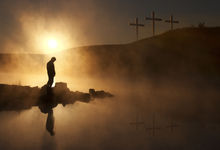Reflection and preparation: on our way to Easter
Easter is not only a date in the calendar. Easter is the culmination and the final destination of a path consisting of many stages. And the starting point is today.

The special thing about Easter is not the external aspect, such as the beginning of spring in the Northern Hemisphere or Easter trees with decorative eggs and ribbons. It is the content that makes Easter. At least for the Christians in the world. On Easter Christians commemorate the resurrection of their Lord Jesus Christ. It is a unique event. And to prepare for this commemoration, to anchor it, there have always been days of preparation leading up to the Easter festival: Palm Sunday, Good Friday, Easter—the so-called Passiontide..
The fast reminds us of our responsibilities
Before Easter, however, there is a period of fasting and praying. The start of the Passiontide is Ash Wednesday—at least according to the universal religious calendar of the Western Church. Forty days of repentance lead up to Easter: quadragesima, which is Latin and means forty. Actually, there are forty-six days to Easter, but the six Sundays are not counted. By observing the forty days of fasting—a period called Lent—Christians replicate the forty days in which Jesus withdrew into the desert and lived an ascetic life. Ashes are an outward sign of repentance. Christians do penance in sackcloth and ashes and begin a period of introspection.
Periods of fasting are also known in other major religions. Islam, for example, is known for its Ramadan. Fasting in the biblical context, however, does not mean following strict rules or spiritual exercises, but rather consciously assuming responsibilities. Human beings have responsibilities for themselves, for their environment, and for life in the world. They are responsible to God, the Creator of all things. This is a view that actually applies all the time, but Lent is a period that serves to remind us of it. In principle, Lent is not about eating little or not eating meat or abstaining from food. The idea is to meditate and reflect on who we are and where we are going.
Cheering gives way to accusation
This is something mankind has always failed in. The Sunday before Easter, Palm Sunday, is an example of this. Palm Sunday marks the beginning of Holy Week, the time of suffering of the Lord. As He entered the city of Jerusalem, the people put down palm branches and shouted hosanna. Everybody was happy, enthusiastic, and full of hope. The crowds were cheering Him, the Saviour of Israel, who would deliver them from the Roman yoke. But history shows us that things turned out completely different. The jubilation made way for accusation; evil knocked on the door.
Maundy Thursday is pay day
On Maundy Thursday—the Thursday before Good Friday—Jesus Christ celebrated the Passover with the Twelve. His arrest was imminent. In the time following, Jesus would be pushed around, would be accused and beaten and murdered. But for now Jesus is still sitting at the table with His disciples. He makes a point of demonstratively showing them what matters: respect and deference. He shows them that it is important to serve one another, to wash one another’s feet, and not to rule and dominate. According to an ancient tradition, Maundy Thursday is a day on which seeds are planted. And Maundy Thursday has always been a day on which interest and debts were paid.
The silence of Good Friday
This is followed by the day of suffering. The lamentations rise and culminate in ultimate grief—all the pomp is forgotten. Everything is quiet and everyone is contemplative. All await the day of resurrection: Easter.
Photo: christakramer - Fotolia





